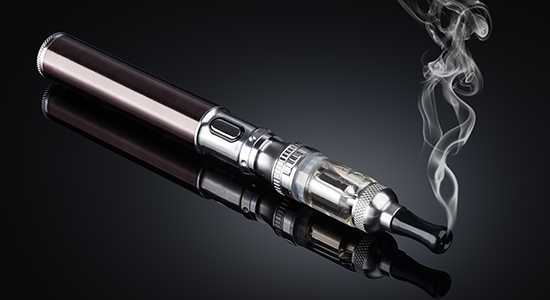
Feb. 20, 2019 – Fewer people are smoking cigarettes. But more people, including many minors, are “vaping” or “juuling,” which refers the use of electronic cigarettes (e-cigarettes), popularized by the e-cigarette company, Juul Labs Inc. Now, the regulators are taking notice.
According to the CDC, cigarette smoking rates among high school students declined significantly from 2011 to 2017, from 16 percent to 8 percent. But during the same period, e-cigarette usage rates increased from 1.5 percent to 20.8 percent.
The U.S. Food and Drug Administration recently published data from a national youth tobacco survey showing a 78 percent increase in e-cigarette use among high schoolers between 2017 and 2018. There was a 48 percent increase among middle schoolers.
The survey revealed an estimated 3.6 million U.S. students, about 1-in-5 high school students (20 percent) and 1-in-20 middle schoolers (5 percent), were “vaping” in 2018. Such e-cigarette usage rates prompted the U.S. Surgeon General to call it an epidemic.
Wisconsin is not immune from the e-cigarette craze: The Wisconsin Department of Health Services (DHS), State Health Officer Karen McKeown, recently issued a public health advisory noting a dramatic increase in e-cigarette use among Wisconsin teens.
In the last five years, e-cigarette use among Wisconsin high school students increased by more than 150 percent. One out of every five students (20 percent) use e-cigarettes. Five years ago, in 2014, only 8 percent of high school students were using e-cigarettes.
DHS recommends strategies to curb e-cigarette advertising and marketing that appeals to youth, as well as reducing access to flavored tobacco products. Federal regulators have already moved in that direction, with underlying lawsuits driving some changes.
What are E-Cigarettes?
An e-cigarette (or e-cig) is an electronic nicotine delivery system that vaporizes nicotine without the traditional combustion process of burning tobacco in cigarettes. Thus, using the various e-cigarette devices available is often referred to as “vaping.”
 Joe Forward, Saint Louis Univ. School of Law 2010, is a legal writer for the State Bar of Wisconsin, Madison. He can be reached by email or by phone at (608) 250-6161.
Joe Forward, Saint Louis Univ. School of Law 2010, is a legal writer for the State Bar of Wisconsin, Madison. He can be reached by email or by phone at (608) 250-6161.
Components can include batteries (power source), atomizers (heating element), and cartridges to hold liquid. The liquid generally consists of nicotine mixed with flavor and other additives such as glycerol, propylene glycol, benzoic acid, and natural oils.1
When a user puffs on an e-cigarette, the battery-powered heating device activates, vaporizes the nicotine-infused liquid, and produces a smoke-like aerosol or “vapor” that is inhaled and exhaled, delivering nicotine to the lungs and into the bloodstream.
Because electronic nicotine delivery systems don’t require combustion – the burning process that releases a multitude of cancer-causing carcinogens into the lungs – vaping is billed as a healthier alternative to smoking for those with nicotine addictions.
The vaping trend among teens is likely attributable to the concealable nature of vaping – aerosol mists resemble smoke but are odorless and vape clouds dissipate quickly. And e-cigarette devices, often resembling pens or sleek USB drives, are easily concealed.
Flavoring is another major draw for young e-cigarette smokers. As one article notes, “the flavoring enhances the appeal to first-time users – especially teenagers.”2
E-cigarette manufacturers develop nicotine-infused concoctions through processes that produce flavor choices like mango, cucumber, fruit, and mint. The DHS advisory noted that there are more than 15,000 e-cigarette flavors available online.
Developing consensus in the health community is that legal restrictions should be implemented to curb e-cigarette use by younger populations, through bans on flavored e-cigarettes or restrictions that make them more difficult for minors to access.
Are E-Cigarettes a Safer Alternative?
Research on the health effects of e-cigarette use is limited, in part because e-cigarettes are a fairly new product and their long-term effects cannot be known.
“At present, it is impossible to reach a consensus on the safety of e-cigarettes except perhaps to say that they may be safer than conventional cigarettes but are also likely to pose risks to health that are not present when neither product is used,” wrote physicians Chitra Dinakar and George O’Conner in The New England Journal of Medicine in 2016.3
However, a more recent study, published in the Journal of Pediatrics, found that vapors inhaled through e-cigarettes contain carcinogens.
“Although e-cigarette vapor may be less hazardous than tobacco smoke, our findings can be used to challenge the idea that e-cigarette vapor is safe, because many of the volatile organic compounds we identified are carcinogenic,” the authors wrote.4
“Messaging to teenagers should include warnings about the potential risk from toxic exposure to carcinogenic compounds generated by these products.”
Others say vaping exacerbates or leads to nicotine addiction, which has long-term health effects and may spawn use of combustible nicotine products later.5 That is, e-cigarettes are fueling the next generation of nicotine-addicted persons, they say.
Regulation of E-Cigarettes
Under the Tobacco Control Act of 2009, the Food and Drug Administration (FDA) has authority to regulate the manufacturing, distribution, and marketing of tobacco products.
Tobacco products include “any product made or derived from tobacco that is intended for human consumption, including any component, part, or accessory of a tobacco product. …” As of 2016, the FDA determined that e-cigarettes, and all the components and parts they use to deliver nicotine into the body, are “tobacco products.”6
Thus, under FDA regulations, e-cigarettes cannot be sold to minors in the U.S. and product packages and e-cigarette advertisements must include a warning that the product contains nicotine and “nicotine is an addictive chemical,” in 12-point font.
While the Tobacco Control Act specifically bans artificial flavors, herbs or spices in “cigarettes,” the law does not expressly ban flavoring additives in e-cigarettes. This has allowed companies like Juul Labs Inc. to sell flavor-based e-cigarettes to the masses.
This has prompted a flurry of litigation. Numerous lawsuits against Juul Labs and other e-cigarette makers allege false and deceptive advertising that targets minors.
For instance, one class action, filed in the U.S. District Court for the Eastern District of Pennsylvania, alleges that Juul, which hit the market in 2015, spread false and misleading information online “to cultivate a youthful, contemporary, sexy, trendy and energetic image of its products with the goal of appealing to a younger demographic.”
The lawsuit seeks damages on various theories, from violations of consumer protection laws to fraud, from strict product liability to breach of express warranty.
At the same time, the FDA is getting involved. In November, the FDA Commissioner announced a move toward regulatory changes that ensure flavored e-cigarettes (other than tobacco, mint, and menthol flavors) “are only sold in age-restricted, in person locations and, if sold online, under heightened practices for age restriction.”
Two days later, Juul announced that it would discontinue its social media presence on Facebook and Instagram and temporarily stop selling its flavored “Juul Pods” to more than 90,000 retailers. Those flavors are now only available on its age-restricted website.
Juul, based in San Francisco, reportedly controls about 70 percent of the e-cigarette market and recently sold a 35 percent stake to Marlboro-maker Altria for $13 billion in cash. Altria valued Juul at $38 billion. According to the New York Times, to the deal involved a $2 billion bonus to be divided among the company’s 1,500 employees.
State Regulation
California is considering a state law that would ban the sale of flavored e-cigarette products in California altogether, and online sales of non-flavored e-cigarettes by postal mail would need conspicuous labeling with a signature by someone age 21 or older. In addition, e-cigarette makers could not market in a manner attractive to those under 21.
Other states are treating e-cigarettes the same as tobacco cigarettes, from a public nuisance perspective. New York, for instance, prohibits the use of e-cigarettes anywhere tobacco cigarettes are banned, including bars and restaurants.
Wisconsin’s public smoking ban, which prohibits smoking in places of employment and enclosed public places, does not apply to e-cigarettes.7
In addition, Wisconsin has no state law that restricts e-cigarette sales or advertising beyond federal law, as contemplated in California, but existing Wisconsin consumer protection laws prohibit false or misleading advertising practices.
While e-cigarette-related legislation was introduced in the Wisconsin Legislature’s last session (2017-18), the bills failed to pass. SB 307 would have required retailers to place e-cigarettes behind counters or in locked cases. AB 159 would have required a statewide model policy for regulating electronic smoking devices on school property.
Endnotes
1 See Juul, https://support.juul.com/home/learn/faqs/juulpod-basics.
2 Id.
3 Dinakar, C. & O’Conner, G., The Health Effects of Electronic Cigarettes, N Engl J Med 2016;375:1372-81, DOI: 10.1056/NEJMra1502466.
4 Rubinstein ML, Delucchi K, Benowitz NL, et al. Adolescent Exposure to Toxic Volatile Organic Chemicals From E-Cigarettes. Pediatrics. 2018;141(4):e20173557.
5 Drazen, J., Morrissey, S., Campion, E., The Dangerous Flavors of E-Cigarettes, N Engl J Med 2019; 380:679-680, DOI: 10.1056/NEJMe1900484.
6 See 81 Fed. Reg. 28974 (May 10, 2016) 82 Fed. Reg. 2193, 2197 (Jan. 9, 2017) (“FDA disagrees with comments stating that vaping hardware does not fall within the definition of ‘tobacco product.’ As the Agency explained in the final deeming regulation, the definition of tobacco product includes components and parts.”)
7 Wis. Stat. § 101.123.
